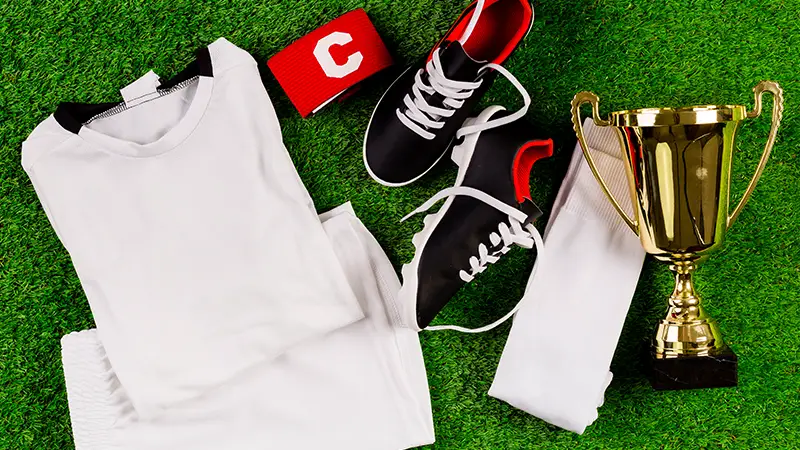When it comes to the world’s most popular sport, soccer, adhering to the equipment rules is essential for players at all levels. From the shoes on their feet to the shin guards protecting their legs, every piece of gear plays a crucial role in ensuring fair play and player safety on the field.
Understanding these regulations not only keeps the game in line with official standards but also enhances the overall experience for everyone involved.
In this article, readers will dive into the intricacies of soccer equipment rules, exploring the dos and don’ts that govern what players can wear during matches.
By familiarizing themselves with these guidelines, both aspiring and seasoned players can elevate their game while staying compliant with the sport’s requirements.
Whether it’s the size of a goalkeeper’s gloves or the color of a team’s jerseys, every detail matters in the world of soccer equipment regulations.
Basic Equipment Rules for Soccer Players
Soccer players must abide by specific equipment regulations to ensure fair play and maintain their safety on the field. These rules cover everything from jerseys to shin guards, with each item serving a critical purpose in the game.
Adhering to these guidelines not only enhances the overall experience but also helps players comply with the sport’s standards.
Jerseys and Shorts
When it comes to jerseys and shorts, players must ensure they are wearing the appropriate team colors specified for their league or tournament. This rule helps differentiate between teams and avoid confusion during gameplay.
Additionally, the jerseys should be numbered on the back as mandated by most soccer organizations for identification purposes.
Socks and Cleats
Socks and cleats are essential pieces of soccer gear that can impact a player’s performance. Socks must fully cover the shin guards and be the same color for all team members to maintain uniformity.
Cleats should be in good condition, without any sharp edges or protrusions that could harm other players.
Shin Guards and Their Importance
Shin guards are crucial for protecting the lower part of the legs from injuries during tackles and collisions. Players are required to wear shin guards that are securely covered by their socks and provide adequate protection.
These guards must be made of suitable material and approved for use in official matches to ensure player safety.
Additional Equipment Rules for Goalkeepers
When it comes to goalkeepers in soccer, there are specific additional equipment rules they need to follow to ensure fair play and safety on the field.
Distinctive Uniforms
Goalkeepers are typically required to wear a different uniform from the rest of the team to distinguish their role on the field. This distinct uniform may include colors that contrast with both teams’ kits to avoid confusion during gameplay.
Adhering to these uniform guidelines helps referees and players easily identify the goalkeeper’s position and maintain order during matches.
Gloves and Other Special Equipment
Goalkeepers are permitted to wear gloves to improve their grip on the ball and protect their hands during dives and saves.
It’s essential for goalkeepers to ensure that their gloves do not pose any danger to other players, such as having sharp elements or excessive padding that could cause injury.
Additionally, any other special equipment worn by goalkeepers, such as padded shorts or headgear, should meet safety standards set by the governing bodies to prevent unnecessary risks during play.
Restrictions and Prohibitions in Soccer Equipment
When it comes to soccer equipment, there are specific restrictions and prohibitions in place to ensure fair play and player safety. It is essential for players and teams to adhere to these guidelines to maintain the integrity of the game.
Jewelry and Accessories
In soccer, wearing jewelry, including necklaces, bracelets, and earrings, is prohibited to prevent safety risks and maintain fair play standards during matches.
- Prohibition of Jewelry: Players are not allowed to wear any jewelry during a soccer match. This restriction is in place to prevent injuries to both the wearer and other players on the field.
- Safety Concerns: Accessories like necklaces, bracelets, rings, and earrings can pose a safety risk if they get caught on a player’s clothing or equipment during gameplay.
- Enforcement: Referees are responsible for enforcing this rule, and players may be asked to remove any prohibited items before entering the field of play.
Technical Devices
Technical devices in soccer, like smartwatches and communication tools, are regulated to maintain fairness and prevent unfair advantages during matches.
- Strict Regulations: The use of technical devices such as smartwatches, fitness trackers, and communication devices is generally prohibited during official matches.
- Fair Competition: These restrictions ensure that all players have an equal playing field and prevent unfair advantages through the use of external technology.
- Exceptions: In some cases, medical devices or religious items may be allowed, but they must be approved by match officials before the game.
Following the restrictions and prohibitions regarding soccer equipment is crucial for maintaining fairness, safety, and the spirit of the game. Players and teams should always prioritize compliance with these rules to uphold the standards of soccer competitions.
Safety Considerations in Soccer Equipment
In soccer, equipment plays a crucial role in preventing injuries on the field by providing necessary protection to players. Properly selected and maintained gear can significantly reduce the risk of potential harm during matches and training sessions.
The Role of Equipment in Preventing Injuries
Soccer equipment plays a vital role in injury prevention, safeguarding players from head, leg, and hand injuries during intense gameplay.
- Head Injuries: Helmets are vital in protecting players from head injuries, especially goalkeepers who may face high-impact collisions when diving or challenging for the ball.
- Foot and Ankle Injuries: Well-fitted cleats with ankle support help stabilize the foot and ankle, reducing the risk of sprains and fractures.
- Leg Injuries: Shin guards are essential in safeguarding the shins from direct impacts or kicks during play, minimizing the risk of serious leg injuries.
- Hand Injuries: Goalkeeper gloves are designed to cushion the impact of fast-moving balls, reducing the chances of hand injuries during saves.
Tips for Maintaining Soccer Equipment
Maintaining soccer equipment ensures safety and performance. Regular checks, proper sizing, cleanliness, and storage are key for durability and player protection.
- Proper Sizing: Ensure that all equipment, including jerseys, shorts, cleats, shin guards, and gloves, fits properly to maximize protection and comfort.
- Regular Inspections: Conduct routine checks of equipment for wear and tear, ensuring that they are in good condition before each game or training session.
- Cleanliness: Regularly clean and maintain gear to prevent the buildup of bacteria or fungi that can cause skin infections.
- Storage: Store equipment in a ventilated area away from direct sunlight and moisture to prolong its lifespan and effectiveness.
By following these guidelines and understanding the importance of soccer equipment in preventing injuries, players can enjoy the game safely while minimizing the risk of accidents on the field.
Common Infringements and Sanctions
In soccer, adherence to equipment rules is vital for fair play and player safety. Violating these rules can lead to penalties and consequences that affect both individual players and teams.
Examples of Equipment Violations
Examples of Equipment Violations in soccer highlight breaches such as unauthorized gear, improper sizing, and non-compliant goalkeeper equipment.
- Wearing unauthorized equipment: Players should ensure they only use approved gear such as jerseys, shorts, socks, cleats, and shin guards to avoid penalties.
- Using non-compliant goalkeeper gear: Goalkeepers must comply with specific rules regarding uniforms, gloves, and safety equipment to avoid infractions.
- Incorrect equipment sizing: Using ill-fitting gear can result in penalties for safety reasons as it may compromise player protection and performance.
- Improper gear maintenance: Failing to keep equipment clean, in good condition, and properly stored can lead to violations of equipment rules.
Sanctions for Equipment Violations
Sanctions for equipment violations in soccer, crucial for fair play and safety, range from warnings to red cards and team fines.
- Verbal warnings: Referees may issue warnings to players for minor equipment violations to ensure compliance without immediate penalties.
- Yellow card sanctions: Players may receive yellow cards for repeated infractions or more serious equipment violations that disrupt the game.
- Red card ejections: Severe equipment violations or persistent disregard for rules can result in players being sent off the field with a red card.
- Team fines: In some cases, teams may face financial penalties for widespread or repeated equipment rule violations that reflect negatively on the sport.
By understanding and following the equipment rules in soccer, players can contribute to a fair and safe playing environment while avoiding unnecessary penalties.
Frequently Asked Questions
What soccer equipment is necessary for fair play and safety?
Players require a uniform (jersey, shorts, and socks), shin guards, cleats, and a properly sized soccer ball. Shin guards must be worn over the socks at all times. Metal and toe cleats are not allowed.
Where can I obtain the required soccer equipment?
Uniforms are available at AYSO registration, while other gear can be purchased at local sporting goods stores. Make sure to involve your child in sizing the uniform.
What should I do with outgrown uniforms or cleats?
Donations of used cleats and uniforms are accepted by our region, which redistributes them to those in need. Recycling your child’s outgrown gear supports our scholarship program.
Conclusion
Compliance with soccer equipment rules is imperative for fairness, safety, and optimal performance on the field. Following guidelines for jerseys, shorts, socks, cleats, shin guards, and goalkeeper gear is essential to prevent injuries and create a responsible soccer community.
Emphasizing adherence to regulations not only promotes fairness and safety but also enhances the overall playing experience by maintaining player safety, preventing injuries, and fostering a culture of accountability within the sport.
Ensuring that all players adhere to the established soccer equipment rules is fundamental to promoting a level playing field while prioritizing safety and performance.
Complying with these guidelines not only safeguards players from potential injuries but also cultivates a sense of responsibility and respect within the soccer community.








Brice Petersen